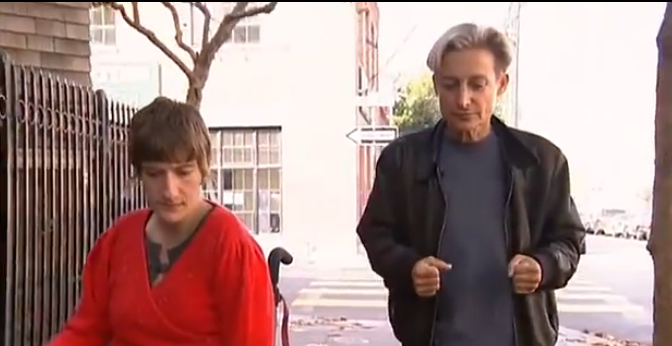
Disability activist Sunaura Taylor and post-structuralist philosopher Judith Butler decided to take a walk through the streets of San Francisco and the resultant video went viral on the Internet. The walk was featured in a film called ‘Examined Life’ directed by Astra Taylor, Sunaura’s sister, and deals mainly with the construction of spaces and bodies and the characterisation of some bodies as ‘normal’ and of others as disabled, hence not normal and therefore not fit to really ‘take a walk’.
In her famous work, ‘Gender Trouble’, Butler opined that there is no ‘natural’ body and that gender is not who someone ‘is’ but what someone ‘does’. Her theory of identity rejects the essentialist conception of gender as a visible difference expressing an underlying natural sexual division. She conceptualises gender as constructed through social rituals supported by institutional power and proposes that gender identities are cultural performances that retroactively construct sexuality. The implication is that gender is a naturalised social ritual of heterosexuality, masquerading as an expression of natural sex and claims that the body is not a ‘natural’ entity but a cultural construction.
Butler puts forth the question posed by Gilles Deleuze in his essay ‘What Can a Body Do?’ She tries to study the body in terms of what the body does, especially if one is to understand the societal attitudes that exist towards the bodies of gender and sexual minorities. The act of doing, according to her, largely shapes the ways in which we ascribe a certain degree of masculinity or femininity to people’s bodies. Of course, this act of ‘doing’ is also subject to the degree to which it is normalised by societal perceptions. Anything that veers dangerously close to subverting it runs the risk of being deemed ‘not normal’. Sunaura quips, ‘When I go into a coffee shop and… pick up a cup [with my mouth] instead of using my hands, it’s sort of undoing this assumption that people take for granted. It’s not even something that people usually think about, that there may be a socially constructed way of using your body.’ Analysing these social constructions that try to shape and transform the way we use our bodies, Sunaura recalls how as a child, when she tried to move without her wheelchair, she was told that she looked like a monkey. Sunaura’s act was a transgression of sorts on her part and led to her being deemed ‘less human, more animal’, hence being compared to a monkey. In the same way, Butler’s ‘Gender Trouble’ also aided the development of queer theory. Since performativity attempted to dismantle rigid categories of sexual or gendered difference, it made heterosexuality, like all gender, performative too, thus rendering to homosexuality and bisexuality the power to subvert dominant, hegemonic, hetero-normative discourses by being the ‘constitutive outside’[1] of heterosexual norms. Drag performances for instance ‘fully subvert the distinction between inner and outer psychic space and effectively mock both the expressive model of gender and the notion of a true gender identity.’[2]
I loved how Taylor not only challenges society’s ideas around her supposed ‘abnormality’ but also completely subverts the common metaphors that one finds popular culture using for people with disabilities all too often; of the disabled person as a desexualised or hyper sexualised, infantilised, or invisible person. Alternately, ‘they’ may appear as possessing miraculous, super human tenacity that helps ‘them’ overcome the obstacle embedded in their disability. Taylor also states early on that all human beings are interdependent in many ways. This is a recurring thought throughout the film. Butler and Taylor’s walk breaks down the ideas of ableism being equated to independence and self-reliance that we seem to have constructed around our selves. Their brief walk questions this idea of individualism, making one think about our need for one another. It explores possibly developing a mutually supportive system that disregards archaic notions of the able/normal and the disabled/abnormal body. It makes one think about the immense potential for change a simple act as innocuous as walking and talking together can hope to create.